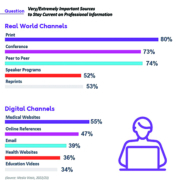Healthcare Agency Roundtable 2022: Uncertainties of 2023: Looming recession, inflation, and reduced investment
Healthcare Agency Roundtable 2022: Uncertainties of 2023: Looming recession, inflation, and reduced investment
By Maria Fontanazza • [email protected]
What changes in the healthcare ecosystem are you most concerned about in the coming year?
Minnie Damle, SVP, Human Resources, Brick City Greenhouse: With the looming recession, clients are now having to rethink how they spend their budget and where money should be allocated. The advantage Brick City Greenhouse has is that we’re not modeled like a big holding company agency. We can bring in very unique and personalized solutions to meet the needs of businesses, while providing high quality and value that allow clients to also balance their budgets.
Fred Kinch, Founder, Content Lead, Brick City Greenhouse: With the recession in mind, as a fully independent agency without any kind of private equity backing or outside influence, we’re very, very flexible in being able to work with our clients and respond as their financial needs change through 2023 and going into 2024. We’re able to be very responsive and flexible in terms of how we work with them, how we handle their billing, how they stretch their dollars, and can help them preserve as many resources as possible while still getting the most impact in the marketplace.
Chris Ozanian, Chief Experience Officer, JUICE Pharma: The past 18 months post-COVID have seen a profound acceleration in healthcare transformation that we do not see slowing down anytime soon. Two technologies together – predictive AI and the expansion of health IoT (internet of things) – are revolutionizing the way patients, and their physicians, are engaging in health management. Putting data privacy aside for the moment, the proliferation of health sensors on devices like the new Apple Watch, other passive health monitors and connected home devices (even those in newer cars) combined with predictive AI cloud services allows for the personalization of the health experience. By passively and actively collecting health data, your phone now becomes a virtual caregiver that adjusts based on your daily behaviors and ongoing goals. This pervasiveness creates a personalized Health OS per se that will make a real impact in changing health behavior. The same can be said on the clinical side, where cloud-based health data collected via consumer and medical monitoring devices is actively being used for remote or hospital-based patient monitoring. For lifesciences companies and their agencies this simply cannot be ignored as we are forging ahead in a world where proving the value of a therapy is becoming more crucial in the broadening discussion of health economics and cost of care.
Kim Wishnow-Per, President, McCann Health Managed Markets, An IPG Health Company: As we look to the future, the most recent landmark law will drive behavior changes and uncertainty across healthcare stakeholders. Nearly half of Americans are covered by Medicare or Medicaid, making the U.S. government the single largest payer. The government’s role in healthcare has been increasing over time in tandem with the growing cost of healthcare and the public interest in access, quality, and affordability.
The Inflation Reduction Act (IRA), signed into law by President Biden in August of 2022, is poised to transform numerous aspects of prescription drug pricing in the Medicare program. The government’s new ability to negotiate prices for some drugs covered under Medicare and the inflation rebate provision may trigger changes that could increase price discounts on pharmaceuticals, causing drug manufacturers to potentially reduce funding for the development of new drugs, thus slowing innovation.
Although the IRA will likely benefit select populations, healthcare access and affordability remains uncertain in other channels, such as: cost reductions recognized by the Medicare program could shift onto consumers with private health plans, resulting in higher costs to employers and employees, and the adoption of alternative payment models may increase dramatically as the balance between costs and quality of care continues to intensify, driving potentially tighter utilization management in certain therapeutic areas.
It is clear the drug pricing reform provisions in IRA will transform how Medicare pays for drugs and provide financial benefits to seniors. However, the pharmaceutical industry will largely bear the brunt of these changes, potentially causing downstream effects on the interconnected healthcare ecosystem.
Jon Koch, Chief Executive Officer, Fishawack Health: One of the most significant challenges facing our clients today and future is the introduction of the U.S. government’s Inflation Reduction Act (IRA), which will include value assessments later in the life cycle and will give Medicare more power to negotiate pricing. Our interdisciplinary teams in Consulting, Policy; Value, Evidence, and Access; Medical, and Marketing are coming together to support our clients in navigating the challenges emerging from this shift in U.S. policy.
The impact of the IRA will reach beyond Medicare services and the U.S., in which Medicare already accounts for more than 30 percent of national prescriptions. Across the industry and the globe, we have already seen companies re-evaluate their portfolios and pipelines, reducing investment in certain products and therapy areas as result of the legislative changes.
The programs most impacted by IRA include small molecules, lifecycle management programs, and diseases affecting the elderly. The impact on portfolios will be significant for many companies and there are concerns that this could hamper innovation. The IRA will undoubtedly create further pressure for emerging biotechnology companies who have already had a tough year when trying to raise capital — with the IRA potentially impacting their strategy for their next round of investment. Alongside assessing their asset strategy, pipeline, clinical strategy, and portfolios, many will need to assess their overall revenue expectations and commercialization strategy, deciding whether to partner or to go alone and if they should focus on the US or the rest of the world. We are working with both our biotech and pharmaceutical clients to support them in overcoming these challenges.
For both established and emerging biopharmaceutical companies, we may see more investment in complex therapeutics and rare diseases, which are less likely to be impacted by the legislative changes. We may also see drug developers evolve their life cycle management approach to prioritize multiple assets with a few targeted indications and launch in multiple indications simultaneously, as well as in more defined patient populations.
The IRA will lead to a rethinking the commercialization model. Manufacturers will also need to make tough decisions about whether they should commercialize all their products and indications in the U.S. and strategies for reducing operational costs. We are collaborating with colleagues at Avalere Health, who specialize in US policy, to develop value assessments and conduct robust scenario planning for our clients. With these insights and tools, we are guiding clients on the type of assets to develop, the optimal indications to pursue, along with the appropriate go-to-market strategy for commercialization.
From a marketing perspective, in the coming years we may see more appetite for innovative, digital-first launches and omnichannel strategies, which can be less costly to implement, drive efficiency, and maintain operating margins, but also give biopharmaceutical companies greater capabilities for reaching their target stakeholders. As a result, marketers should begin to consider their digital ecosystem and how well-equipped they are for delivering these personalized and connected experiences.
Our steadfast advice for our clients is to remain pragmatic, taking a considered approach to ensure new opportunities that may emerge from the policy and competitors’ actions in response to the policy aren’t missed.
Michelle Whitlock, EVP, Specialized Engagement Solutions, Ogilvy Health: Like the vast majority of Americans, I am watching my living expenses increment – or leap – northward thanks to inflation, while simultaneously handling the caretaking of a senior parent on a fixed income. So, I often think about the difficult choices and trade-offs people are likely to have to make in the coming year when deciding between paying for the general necessities and then also paying for needed medications. This is a harsh reality that will reach far beyond the elderly and those in vulnerable populations and will become manifest for even middle-income families. Layer on the pressurized financial bedrock strata of rising chronic illness, increased mental health challenges, and the emerging long-term effects of COVID, and we have a looming medication fill and adherence crisis with life-altering or even life-threatening repercussions on our hands. What is our responsibility as medical marketing professionals in the face of this unstable dynamic? What role can we play in mitigating its worst effects? One answer lies in ensuring that information about affordability and adherence assistance programs are amplified and ubiquitous, and that no stone is left unturned in educating patients and providers about support options.
According to IQVIA, pharmaceutical manufacturers spend $14 billion on patient support and adherence programs each year. Despite this investment, patient awareness is very low. In a survey of 12,000 patients conducted by Accenture, only 16 percent of patients were aware of available support programs. We need to find innovative approaches and under-utilized channels to amplify this information. For example, Pharma should harness the opportunity presented by the shifting consumer social ecosystem and reach consumers where they are today – notably TikTok, Reddit, and other non-traditional marketing platforms. We also see live or telehealth point-of-care engagement as an educational opportunity that often goes underutilized. There is a significant opportunity to drive financial assistance and enrollment into patient support programs at the point of prescribing in the electronic health record. Healthcare providers can send money-saving offers and enrollment tools to patients directly via SMS with the click of a button while sending a prescription to the pharmacy. Much more can, should, and needs to be done to help patients afford, fill, and stay on their medications. Reaching patients with programs that can help them weather economic uncertainty should be an urgent priority, and our collective creativity as healthcare marketers has never been more sorely needed.
Mike Myers, Managing Director and Partner, CrowdPharm: My biggest concern is the ongoing focus on removing the tax deductibility of healthcare promotion for pharmaceutical companies. The push in this area is shortsighted in my view. It will hurt broad segments of the industry in the U.S., and ultimately, negatively impact patients who will receive less information on needed healthcare treatments.
John Guarino, President, Managing Partner, Peregrine Market Access: In our minds, the biggest changes are the Medicare reforms associated with the Inflation Reduction Act and the continuation of vertical integration we have seen in the largest U.S. payers and their organizations.
For Medicare, the change that will be impactful isn’t the “new” ability to negotiate pricing for drugs (ask anyone who calls on a Medicare Advantage plan, this has been happening for years), it is the reduction in OOP requirements for patients in the Part D plans. The prescription drug program was a good first step in 2003, but for a long time it was an inadequate benefit for expensive specialty products. Under the new law, the OOPs will come in line with what commercial plans require for specialty drugs.
Also, the continued vertical alignment and consolidation in the top commercial plans will blur the lines not only between commercial and managed government plans but also distribution channels and ultimate access for patients. Previously, things like benefit design, specialty pharmacy, hospital affiliation, and distribution channel were isolated, independent parts of the value chain. The opportunity to streamline access and help patients receive their therapies is significant, but only if we can break down misaligned incentives for each stakeholder.
Christopher Dimmock, SVP, Integrated Strategy, AbelsonTaylor: The Centers for Disease Control and Prevention needs to restore its credibility and trust as a nonpolitical entity. According to a poll conducted last spring by the Robert Wood Johnson Foundation and the Harvard T.H. Chan School of Public Health, only half the citizens of this country trust the CDC and this varies dramatically by political affiliation.
Unfortunately, American trust in government has suffered significantly in recent years and the charged environment of the global COVID pandemic thrust the CDC into the front lines of partisanship. This environment undermined its role as a scientific policymaker and may have weakened its ability to deliver on its mission and positively influence the well-being of the country. The role of the CDC in the healthcare ecosystem has been obfuscated. For the safety and well-being of the U.S. population, and the healthcare community in particular, the CDC will need to clarify and restore its role as an apolitical trusted entity. Through clear communication and the issue of science-based policy, its mission as “the nation’s leading science-based, data-driven, service organization that protects the public’s health” will help retrieve its leadership and restore confidence in the overall healthcare ecosystem.
Brian Wagner, VP Product Strategy, CMI Media Group: Not so much about being concerned, it is more about being aware and ahead of the industry. We have always looked at ourselves as trailblazers and early adopters to new technology, and seeking newer, interesting, and value-driven, effective options for our clients. Hence, with the end of tracking/targeting cookies on the horizon, we have spent a great deal of time exploring cookieless options that will deliver better value to our clients. We are currently running some cookieless activations, while continuing our exploration into others, with hopes of gaining good insights and learnings enabling us to hit 2023 ready to go with those opportunities that show promise and bring value. Another example is getting ahead of data privacy legislation that is slowly rolling across the country but may still be years away from a single federal policy. For example, the types of health data that we access, how it is used, the desired outcome, is based on the specific use cases and business objectives. There’s no one solution for all uses. For example, an analysis of the impact of a media campaign uses different data sets and is structured to meet that specific use case. A condition audience model again, different use case, uses different data sets and goes through a rigorous compliance review.
What is common in these examples is the use of de-identified data, and those analyses being completed in a secure setting, sometimes termed a “clean-room”. In addition, we do not collect, nor store any PHI data. All our data analyses and use cases are undertaken with great scrutiny, ensuring meeting with data privacy good and best practices as well as following industry guidelines such as Network Advertising Initiative (NAI) guidelines and others.
Jacob Harrison, Director Ecommerce, CMI Media Group: There are several different factors of concern in the ecommerce ecosystem. The first is inventory control. Ecommerce retailers used to order large amounts of inventory and store on behalf of the client, leaving the client with the revenue from the purchase and without the cost of storing product. With COVID, organizations ordered a lot of inventory concerned with the ability to replenish with shipping restraints. Now, the e-retailer knows this and no longer orders more than they absolutely have to, leaving our clients to hold the bag if they don’t sell-thru product. Inflation is the second area of concern. With the pricing of shipping, storage, etc. going up with rising inflation, will the e-retailer be interested in our product? If price point of the product is not correct and if clients can’t meet promotional opportunities, it is likely that the e-retailer will not continue relationships. Finally, is the e-retailer willing to continue to push into the space? There are a lot of hurdles and compliancy issues both with the federal government and with the consumer that have to be overcome. There has to be a willingness to test and learn and continue to drive the category forward from the e-retailer and from partners like CMI Media Group. With the consumer’s growing concern in regards to use of their PII, it is going to have to be handled in a delicate manner and constantly monitored for feedback to ensure that this work is being done properly.
Faruk Capan, CEO, EVERSANA INTOUCH & Chief Innovation Officer, EVERSANA: In the coming year, it’s going to be a tougher market for healthcare players. Although pharma isn’t usually hit as hard in a recession, rapidly rising interest rates and inflationary pressure will make capital investments and M&A activities very challenging in the near term.
Boris Kushkuley, Ph.D., President, Commercial and Consulting, EVERSANA INTOUCH: Recession will cast a large, dark cloud on all aspects of our industry. It can have a significant effect on the affordability of pharmaceutical products for patients, put additional pressures on pharmaceutical companies from payers as well as choke influx of R&D financing for new medications. As costs of healthcare continue to rise, we’ll see a continued focus on long-term outcomes, real-world evidence and HEOR research to prove the value of new products. Payers and organized customers (hospital networks and IDNs) will continue to enforce strict treatment protocols often based on reducing costs and the use of generics. In this situation, branded products need to focus on an overarching value story going beyond clinical benefits of the products.
Healthcare Agency Roundtable 2022: Tech trends, opportunities, and woes (Part III)
Healthcare Agency Roundtable 2022: Moving into 2023 (Part V)
| Maria Fontanazza is the director of content, Med Ad News and PharmaLive.com. |



















 Reuters
Reuters
